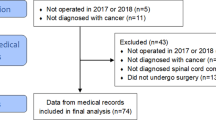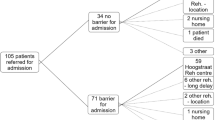Abstract
Study design: Retrospective descriptive study.
Objectives: (1) To obtain an overall appraisal of patients with epidural metastatic spinal cord compression (SCC) admitted to nine Dutch spinal cord units (SCUs) between 01-01-1990 and 01-01-2000. (2) To identify factors that predict survival >1 year after in-patient rehabilitation of patients with epidural metastatic SCC.
Setting: Dutch SCUs. Rehabilitation Center Amsterdam, Amsterdam. Rehabilitation Center Heliomare, Wijk aan Zee. Rehabilitation Center De Hoogstraat, Utrecht. Rehabilitation Center Rijndam, Rotterdam. Rehabilitation Center Sophia Stichting, Den Haag. Rehabilitation Center Beatrixoord, Haren. Rehabilitation Center Het Roessingh, Enschede. Rehabilitation Center Sint Maartenskliniek, Nijmegen. Rehabilitation Center SRL Hoensbroeck, Hoensbroek.
Methods: (1) Clinical records were reviewed and demographic, clinical and functional data were collected according to a protocol. The date of admittance to the SCU, rehabilitation goals, date of discharge and date of death were recorded. (2) The odds ratio (OR) was calculated for all determinants on admittance to the SCU in order to find indicators that predict survival >1 year after discharge from the SCU. An OR ⩾2 was considered to be clinically significant.
Results: In total, 131 patients with epidural metastatic SCC were admitted. In all, 117 clinical records were retrieved and 97 clinical records provided complete data. The average age on admittance was 58 years. Among the patients 53% were male. The average Barthel score on admittance was 7.2/20 points. The average length of stay in the SCU was 104 days (3–336). Overall, 66% of the patients were discharged. The average Barthel score on discharge was 12.0 points. The average survival after discharge was 808 (0–3669) days. During their stay on the SCU, seven patients died. At 1 year after discharge, 52% of the patients were still alive. These patients suffered less complications, had been admitted less often to a hospital during rehabilitation, had made better functional progress and had been discharged home more often. A survival >1 year after discharge is related to ASIA D (OR 4.3), MRC 4 and 5 (OR 5.4), tumour in remission (OR 3.8) and independence or partial independence on the Barthel items: dressing (OR 4.3) and making transfers (OR 5.0).
Conclusions: Patients with epidural metastatic SCC may benefit from in-patient rehabilitation.
Similar content being viewed by others
Log in or create a free account to read this content
Gain free access to this article, as well as selected content from this journal and more on nature.com
or
References
Barton KD, Hirano A, Akari S, Terry RD . Experience with metastatic neoplasm involving the spinal cord. Neurology 1959; 9: 91–105.
Bailar III JC, Gornik HL . Cancer undefeated. N Eng J Med 1997; 336: 1569–1574.
Haddart RA, Rajan B, Law M, Meyer L, Dearnaly DP . Spinal cord compression in prostate cancer: treatment outcome and prognostic factors. Radiother and Oncol 1997; 44: 229–236.
Sundaresan N, Steinberger AA, Moore F, Sachdey VP, Krol G, Hough L . Indications and results of combined anterior and posterior approaches for spine tumour surgery. J Neurosurg 1996; 85: 438–446.
Grant R, Papadopoulos SM, Greenberg HS . Metastatic epidural spinal cord compression. Neural Clin 1991; 9: 825–841.
Fornasier VL, Home JG . Metastases to the vertebral column. Cancer 1975; 36: 590–594.
Abdu WA, Provencher M . Primary bone and metastatic tumors of the cervical spine. Spine 1998; 23: 2767–2777.
Hammerberg KW . Surgical treatment of metastatic spine disease. Spine 1992; 17: 1148–1153.
Sioutos PJ, Arbit E, Meshulam CF, Galachich JH . Spinal metastases from solid tumors Analysis of factors affecting survival. Cancer 1995; 76: 1453–1459.
Murray PK . Functional outcome and survival in spinal cord injury secondary to neoplasia. Cancer 1985; 55: 197–201.
Ampill FL . Epidural compression from metastatic tumour with resultant paralysis. J Neuro-Oncol 1989; 7: 129–136.
Dunn RC, Kelly WA, Wohns RNW, Howe JF . Spinal epidural neoplasia: a 15 year review of the results of surgical therapy. J Neurosurg 1980; 52: 47–51.
Livingstone KE, Perrin RG . The neurosurgical management of spinal metastases causing cord and cauda equina compression. J Neurosurg 1978; 49: 839–843.
Soelberg SP, Borgesen SE, Ramusson B, Boge-Ramussen T, Holt Larsen B, Gjerris F . Metastatic epidural spinal cord compression. Cancer 1990; 65: 1502–1508.
Bach F Larsen B, Rohde K, Borgesen S, Gjerris F, Boge-Rasmustoms T et al. Metastatic spinal cord compression, occurrence, symptoms, clinical presentations and prognosis in 398 patients with spinal cord compression. Acta Neurochir 1990; 107: 37–43.
McKinley WO, Seel RT, Hardman JT . Nontraumatic spinal cord injury: incidence, epidemiology, and functional outcome. Arch Phys Med Rehab 1999; 80: 619–623.
McKinley WO, Conti-Wyneken AR, Vokac CW, Cifu DX . Rehabilitative functional outcome of patients with neoplastic spinal cord compression. Arch Phys Med Rehab 1996; 77: 892–895.
McKinley WO, Huang ME, Brunsvold KT . Neoplastic versus traumatic spinal cord injury: an outcome comparison after inpatient rehabilitation. Arch Phys Med Rehab 1999; 80: 1253–1257.
McKinley WO, Huang ME, Tweksbury MA . Neoplastic versus traumatic spinal cord injury: an inpatient rehabilitation comparison. Am J Phys Med Rehab 2000; 81: 359–363.
Hacking HGA, Van As HHJ, Lankhorst GJ . Factors related to the outcome of inpatient rehabilitation in patients with neoplastic spinal cord compression. Paraplegia 1993; 31: 367–374.
Sackett DL, Haynes RB, Tugwell P . A basic science for clinical medicine. In: Clinical Epidemiology. Little, Brown and Company: Lippincott Williams & Winkins, 1991.
Schonherr MC, Groothoff JW, Mulder GA, Eisma WH . Rehabilitation of patients with spinal cord lesions in The Netherlands: an epidemiologic study. Spinal Cord 1996; 34: 679–683.
Author information
Authors and Affiliations
Rights and permissions
About this article
Cite this article
Eriks, I., Angenot, E. & Lankhorst, G. Epidural metastatic spinal cord compression: functional outcome and survival after inpatient rehabilitation. Spinal Cord 42, 235–239 (2004). https://doi.org/10.1038/sj.sc.3101555
Published:
Issue date:
DOI: https://doi.org/10.1038/sj.sc.3101555
Keywords
This article is cited by
-
Clinical outcome of surgical management for symptomatic metastatic spinal cord compression from prostate cancer
BMC Urology (2020)
-
Challenges in rehabilitation of patients with nontraumatic spinal cord dysfunction due to tumors
Wiener klinische Wochenschrift (2019)
-
Factors predictive of survival and estimated years of life lost in the decade following nontraumatic and traumatic spinal cord injury
Spinal Cord (2017)
-
Understanding the Role of Rehabilitation Medicine in the Care of Patients with Tumor Causing Spinal Cord Dysfunction
Current Physical Medicine and Rehabilitation Reports (2017)
-
Cancer rehabilitation: a barometer for survival?
Supportive Care in Cancer (2015)



